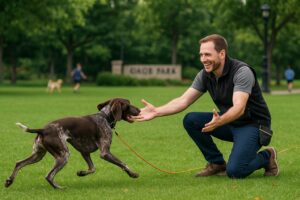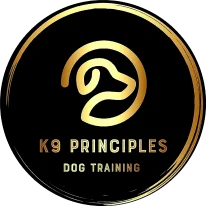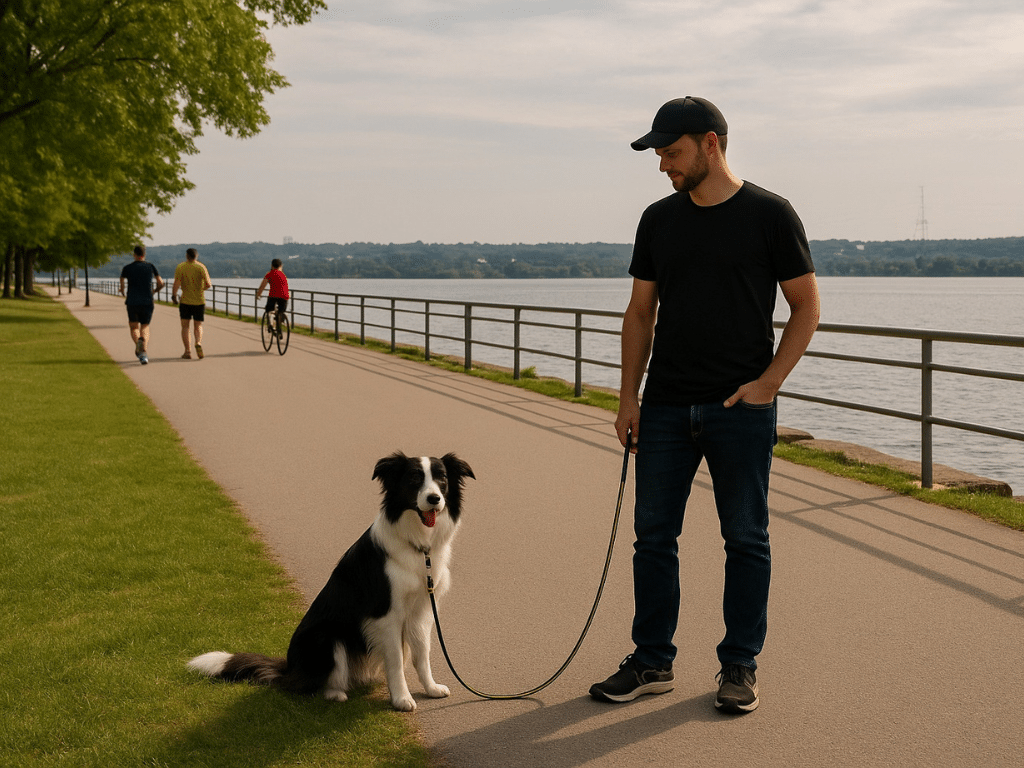Distraction training is one of the most valuable skills you can ever teach your dog. At K9 Principles, we see countless owners who proudly tell us their dog has mastered sit, stay, and recall inside the living room. Yet the moment they step outside into the hustle and bustle of Hamilton’s streets, everything falls apart. The perfectly behaved dog at home suddenly refuses to listen, lunges at passing dogs, or ignores their recall when a squirrel scurries across the path. This is the difference between obedience in a controlled setting and true reliability in the real world. Distraction training is the art of bridging that gap, and it’s what separates an average dog training experience from one that transforms your bond with your dog for life.
Distraction training is not about teaching new commands; it’s about reinforcing focus when the world is at its noisiest. It is the ability for your dog to choose you over the chaos around them, whether that chaos is a jogger brushing past on Bayfront Park’s trails, the smell of food at a summer festival, or the excitement of another dog racing across the field. And at its core, distraction training is about building calmness, trust, and clear communication so your dog learns that listening to you pays off more than reacting to the environment.
Understanding Distractions
Before you can begin distraction training, it’s important to understand what a distraction truly is. To us, a distraction might be a car passing by or a neighbour saying hello. To a dog, these moments can feel overwhelming, triggering instinctive reactions that are difficult to ignore. Distractions fall into two main categories: environmental and social. Environmental distractions are things like traffic noises, wildlife, food scents, or sudden movements. Social distractions involve interactions with people or other animals, such as a dog running by or children shouting in a playground. Both categories require careful training because they test your dog’s ability to stay composed.
It’s also important to recognise that distractions vary in predictability. You can plan for some, like a family member walking past during a training session. Others, like a cyclist suddenly appearing on a trail, are unpredictable and therefore far more challenging. Successful distraction training prepares your dog for both situations, helping them learn to generalise focus in any environment.
The Role of Genetics and Drives
Every dog has genetic traits and instinctive drives that influence how they respond to distractions. A Border Collie is genetically wired to notice movement because of its herding background, while a Beagle has an extraordinary nose that constantly seeks out scents. A German Shepherd might naturally feel protective and more inclined to react to strangers. Understanding your dog’s breed tendencies helps set realistic expectations for distraction training. It doesn’t mean your dog cannot learn to focus, but it does mean the training process may look different depending on their instincts.
At K9 Principles, we regularly work with families in Hamilton who are frustrated because they believe their dog is “stubborn” or “untrainable.” The truth is often that their dog is simply following genetic drives. Once we align training methods with those instincts, we can build reliable focus no matter the breed.
The Foundations of Focus
Before introducing distractions, your dog must first understand clarity. If your dog doesn’t know what a cue means in a quiet living room, expecting them to follow it in Gage Park on a Saturday afternoon is unrealistic. Clarity comes from consistent marker training, timing your reinforcement correctly, and rewarding behaviours until they become second nature.
 Repetition builds history. A dog that has rehearsed sit and stay hundreds of times in a calm environment has a foundation that can later be tested with distractions. Trust between you and your dog is essential here. Your dog must believe that focusing on you will always result in something good, whether that’s food, play, or praise. That foundation is what allows you to step outside and gradually layer in the challenges of the real world.
Repetition builds history. A dog that has rehearsed sit and stay hundreds of times in a calm environment has a foundation that can later be tested with distractions. Trust between you and your dog is essential here. Your dog must believe that focusing on you will always result in something good, whether that’s food, play, or praise. That foundation is what allows you to step outside and gradually layer in the challenges of the real world.
The Science Behind Distraction Training
The canine brain is wired to respond quickly to external stimuli. Dogs are not naturally skilled at splitting their focus; they are designed to notice every rustle, movement, and sound. This makes sense from a survival perspective but poses challenges when training. Distraction training works with the brain by using habituation and desensitisation. Over time, dogs learn that distractions are not dangerous or exciting but simply background noise.
Dopamine also plays a role in attention. When your dog anticipates a reward, dopamine is released in the brain, making reinforcement a powerful tool to shape focus. By consistently rewarding your dog for ignoring distractions, you change their internal motivation. Suddenly, the jogger passing by is less important than the chance to earn a treat or a game of tug.
One of the guiding principles in distraction training is the “Three D’s”: Duration, Distance, and Distraction. You cannot increase all three at once. If your dog can stay for 10 seconds at home, you cannot expect them to stay for two minutes at the park while other dogs run around. You must gradually increase each element, ensuring success builds without overwhelming your dog.
Step-By-Step: Introducing Distractions
The art of distraction training begins with small, controlled challenges. At first, you might simply place a toy nearby while asking your dog to sit. Once they master that, you progress to someone gently walking past, or a family member dropping an object across the room. Each step is designed to build resilience in a safe environment.
 From here, you progress into real-life scenarios. Hamilton offers a perfect training ground: parks, trails, cafés, and bustling neighbourhoods. Using a long line for safety, you begin testing recall in open spaces, gradually increasing the challenge. For example, starting on a quiet side street before moving to a busy trail ensures your dog builds confidence step by step.
From here, you progress into real-life scenarios. Hamilton offers a perfect training ground: parks, trails, cafés, and bustling neighbourhoods. Using a long line for safety, you begin testing recall in open spaces, gradually increasing the challenge. For example, starting on a quiet side street before moving to a busy trail ensures your dog builds confidence step by step.
The key here is progression, not perfection. Each success tells your dog, “You made the right choice by focusing on me.” This is how long-lasting reliability is created.
Common Challenges in Distraction Training
Many owners face the same challenges when teaching their dog to focus. Over-excitement around other dogs is one of the most common. Dogs naturally want to interact, but distraction training teaches them that neutrality is more rewarding. Instead of dragging you towards another dog, they learn that staying calm earns reinforcement.
Fear-based reactions are another challenge. Some dogs bark, lunge, or hide when overwhelmed by a distraction. Recognising stress signals is critical here. If your dog is showing avoidance or anxiety, pushing them harder will backfire. Instead, distraction training must be adjusted to their emotional state, starting with easier scenarios and building confidence gradually.
Owner mistakes are also a factor. Timing is everything in distraction training, and rewarding too late or allowing your dog to practise unwanted behaviours creates setbacks. Another mistake is overloading the dog too quickly by exposing them to environments they are not ready for. Structured progression, guided by an experienced K9 Principles dog trainer, avoids these pitfalls.
Advanced Techniques
As your dog progresses, distraction training moves beyond food rewards and into more advanced reinforcement strategies. Variable reinforcement—where rewards are unpredictable—creates stronger behaviour because the dog learns to work harder, not knowing when the next reward will come.
Impulse control also becomes central at this stage. Cues like “leave it” and “stay” are tested under real pressure. For example, teaching a Labrador to stay calm while food drops on the ground is distraction training at its finest. Games that promote self-regulation, like waiting at doorways or sitting before play, help generalise control.
 Proofing under high distraction is the final test. This means taking your dog into environments full of triggers—farmers’ markets, busy Hamilton trails, or outdoor events—and expecting reliability. The goal is not to eliminate distractions but to teach your dog that focus remains the most rewarding option, no matter the environment.
Proofing under high distraction is the final test. This means taking your dog into environments full of triggers—farmers’ markets, busy Hamilton trails, or outdoor events—and expecting reliability. The goal is not to eliminate distractions but to teach your dog that focus remains the most rewarding option, no matter the environment.
The Role of the Handler
Distraction training is not just about the dog; it’s about the handler. Dogs are acutely sensitive to our body language, tone, and energy. If you approach distraction training with tension or frustration, your dog feels it and mirrors that behaviour. Calm, confident energy sets the tone for success.
There is also a balance between leadership and micromanagement. True distraction training is not about constantly nagging your dog with cues. Instead, it is about building a relationship where the dog chooses to pay attention. That comes from trust, clarity, and consistency. A micromanaged dog listens out of pressure; a well-trained dog listens out of choice.
Why K9 Principles Prioritises Distraction Training
At K9 Principles, we know distraction training is the cornerstone of real-world reliability. Living in Hamilton means your dog will inevitably face a wide variety of distractions, from busy city parks to family gatherings. We design our Hamilton dog training courses to prepare your dog for exactly these environments, ensuring they are calm and reliable when it matters most.
Our reputation as the trusted dog trainers for the Hamilton/Burlington SPCA speaks for itself. Families choose us because our methods are proven, our results are long-lasting, and our approach is always tailored to each dog. We understand the local community, the environments dogs face here, and the challenges owners encounter daily. That’s why our distraction training is trusted across Hamilton and beyond.
From Chaos to Calm
One of our clients came to us with a young Belgian Malinois who seemed impossible to control. At home, he responded beautifully to sit, stay, and recall. The moment they stepped outside, however, he lunged at other dogs, barked at joggers, and dragged his owner across the pavement. His family felt defeated, convinced he would never calm down.
Through structured distraction training, we began by rebuilding his foundation in quiet spaces, then gradually introduced controlled distractions. Using a long line, we progressed to neighbourhood walks, rewarding calmness at every step. Slowly but surely, he learned that ignoring distractions and focusing on his owner was far more rewarding than reacting. Today, he walks calmly through Hamilton’s busiest parks, responding to recall even when dogs run past. His transformation is a testament to the power of distraction training and the dedication of his owner.

If you’re ready to experience this transformation, our team at K9 Principles is here to guide you every step of the way. With proven methods, trusted partnerships, and deep roots in Hamilton’s community, we deliver dog training that truly lasts.
Contact us for more information:
- Name: K9 Principles
- Address: Haldimand County, Greater Hamilton Area, Burlington, and Most of Norfolk County
- Phone: 289 880-3382
- Email: k9principlesinc@gmail.com
- Website: www.k9principles.ca
FAQs
-
A1.The length of distraction training depends on your dog’s breed, age, and history, but most families begin to see improvements within weeks. Reliable results come from consistency over months, not days.





